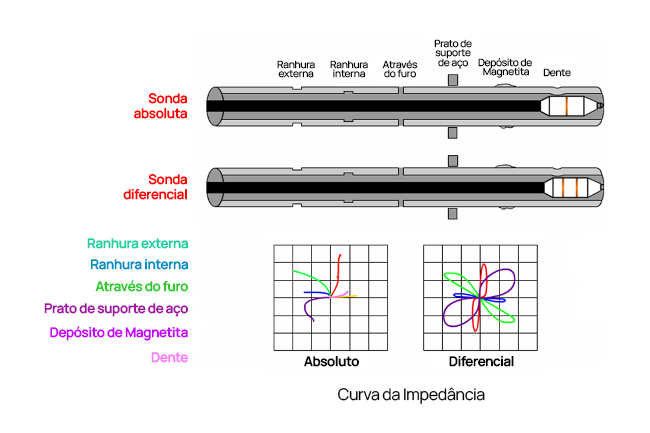EC - TUBE INSPECTION
MULTIFREQUENCY AND MULTICHANNEL TECHNIQUE - ASME V ARTICLE 8
Examination of heat exchanger tubes made of non-magnetic materials such as austenitic stainless steels, copper, nickel, aluminum and titanium alloys. Tubes are scanned by internal probes and have the highest definition and accuracy of any non-destructive method available. It is possible to accurately distinguish the depth of pits and cracks on the internal and external surfaces of the tubes up to 95% of the thickness.
It is a technique of the electromagnetic method, which consists of “sweeping” the entire length of the tube using one or more probes that generate magnetic fields that induce eddy currents in the examined tubes.
The presence of discontinuities causes a disturbance in the impedance of the test system which is correlated to artificial defects with known dimensions, induced in tubes similar to those tested (standard tubes). This correlation is represented by the “impedance plane”.
Among all the techniques, it is the one with the greatest sensitivity and versatility, as it is capable of detecting and measuring (with some limitations) all types of damage normally found in tubes, from localized and extensive thickness losses to circumferential cracks, longitudinal and branched, through the use of updated equipment and software that allow operation with multiple frequencies, multiple absolute and differential channels and different types of probes (flexible, pancake, rotary, weld scan, coils, etc. – See figure 20).
The main problem observed in eddy-current inspection arises when mirrors or baffles are made of materials similar to tubes; this situation can cause “distortions” in the signals that limit the detection and dimensioning of damage.
It is a technique of the electromagnetic method, which consists of “sweeping” the entire length of the tube using one or more probes that generate magnetic fields that induce eddy currents in the examined tubes.
The presence of discontinuities causes a disturbance in the impedance of the test system which is correlated to artificial defects with known dimensions, induced in tubes similar to those tested (standard tubes). This correlation is represented by the “impedance plane”.
Among all the techniques, it is the one with the greatest sensitivity and versatility, as it is capable of detecting and measuring (with some limitations) all types of damage normally found in tubes, from localized and extensive thickness losses to circumferential cracks, longitudinal and branched, through the use of updated equipment and software that allow operation with multiple frequencies, multiple absolute and differential channels and different types of probes (flexible, pancake, rotary, weld scan, coils, etc. – See figure 20).
The main problem observed in eddy-current inspection arises when mirrors or baffles are made of materials similar to tubes; this situation can cause “distortions” in the signals that limit the detection and dimensioning of damage.

